After the GM A-bodies became G-bodies, each division did its own thing when it came to deciding what models stayed in the lineup. Consider the sedans: The Chevy and Buick versions departed after ’83. Pontiac’s G-body Bonneville lasted until 1986, after which it became an H-body. But Oldsmobile, arguably the purveyor of the best A/G-bodies in the corporation, kept its sedans going all the way to 1987. All in all, not a bad run for an Olds model that had flopped (at least in four-door form) when it first appeared in 1978.
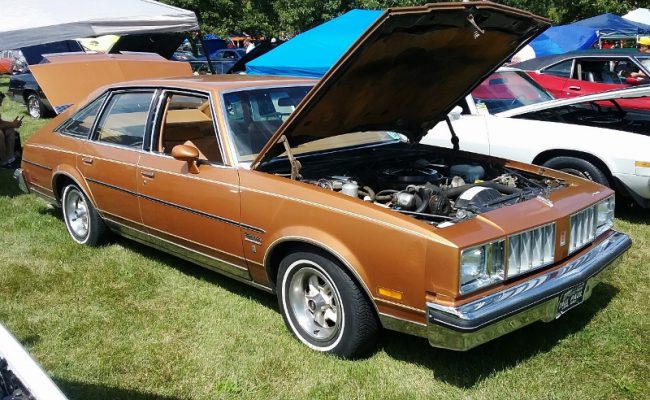
1978 Cutlass Salon Brougham, seen at the 2018 Grape Festival car show, Nauvoo, Illinois
And just why did the Aeroback Cutlass Salon two- and four-door sedans bomb? First of all, coupes reigned supreme (pun most definitely intended) in 1978.
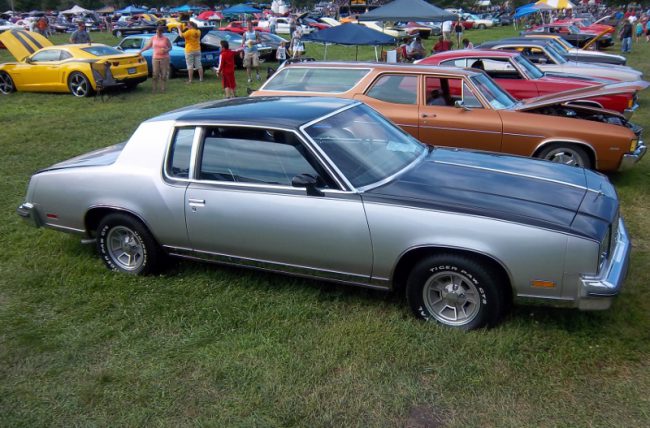
1979 Cutlass Calais at the 2014 Grape Festival car show, Nauvoo, Illinois.
The formal roofed, oft-Landau topped Supremes were the bee’s knees, while the Aeroback Salons were, well, different. Very different, especially to folks looking to trade in their Colonnade ’75 Cutlass Supreme sedan, and seeing this very un-Oldsmobile like vehicle sitting in the showroom.
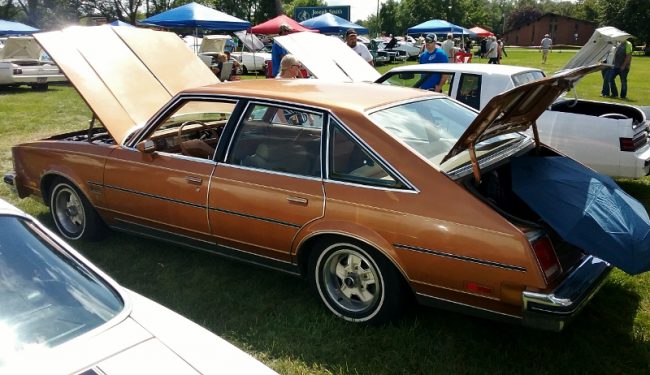
While the look was rather European, in an Americanized kind of way, most folks just didn’t take to it. The traditional three-box styled LeMans and Malibu cousins did much better than the Cutlass Salon, and its Buick brethren. While I like the Aerobacks, admittedly, I like a lot of oddball stuff.
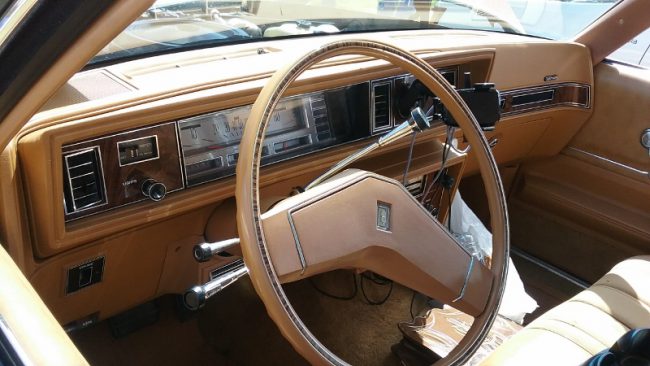
Still, Oldsmobile probably wasn’t terribly broken up about that, since at the same time they were selling truckloads of Cutlass Supreme coupes and Brougham coupes. Recall that 1977 Cutlass Supreme coupes outsold all the Cutlass four-doors and station wagons, combined.
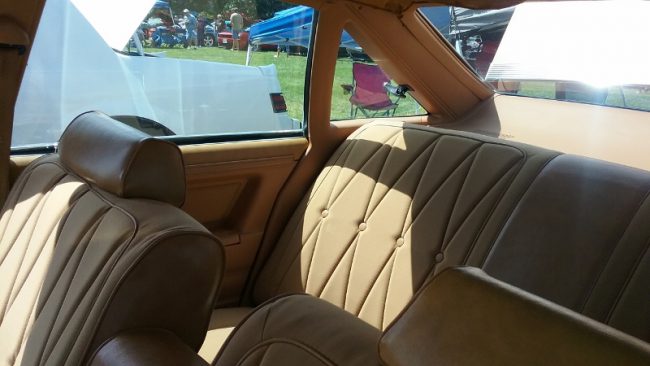
Still, it didn’t do well for Oldsmobile’s image to have Aerobacks languishing in the lineup. Especially when buyers who didn’t want a fastback sedan could walk across the street and buy a Grand LeMans or Malibu Classic.
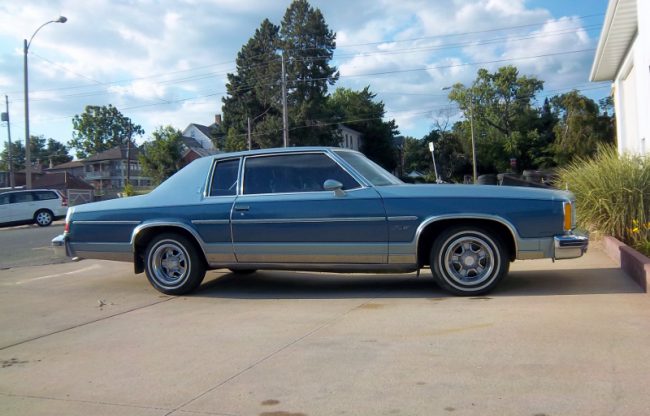
Or just upgrade to a Delta 88. After all, the 1977-79 downsized B-bodies were one of the best full-sizers ever made, and the Olds version was especially handsome.
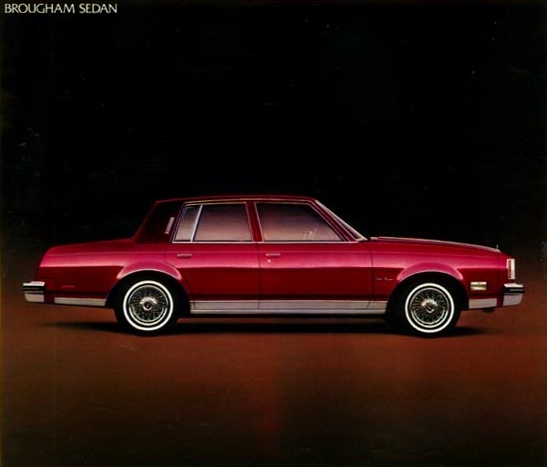
As a result, for 1980 Olds treated the four-door to a formal-roofed makeover (as did Buick), exhibiting the now-GM trademark ‘sheer look’, as originated on the 1976-79 Cadillac Seville. It sold far better than its 1978-79 Cutlass Salon predecessor.
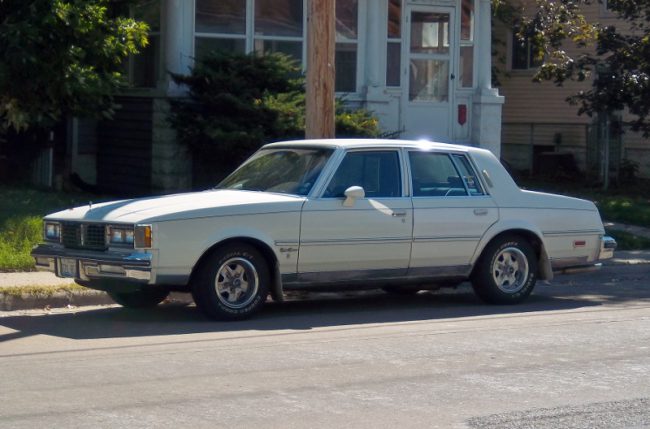
While it may have had obvious stylistic overtones vis a vis the Seville, it did look nice. Certainly Olds buyers didn’t mind the resemblance. GM took a lot of flak for similar-appearing cars as the ’80s wore on. Which I have always found amusing, since no one seemed to be bothered by Mercedes-Benz and BMW doing essentially the same thing at the time. But I digress…

In 1986, the Cutlass Supreme coupes still looked fresh (and remained remarkably popular) after an attractive 1981 makeover, but aside from annual updates to trim, wheel covers, grilles and tail lights, the Supreme four-door hadn’t changed much since 1980. Nonetheless, the CS line was still going gangbusters, and plenty of folks–young folks, even–wanted a Cutlass Supreme in their driveway. These were comfortable, cushy cars, particularly in Brougham trim. Wanna ride through town in your favorite chair? One of these was a perfect solution.

How did Olds do it? Plush, floating-pillow seating. Although this is a coupe interior, the Brougham sedans got the very same thrones. Not everybody wanted BMWs in the mid-’80s, and particularly not Midwesterners. When I was a little kid, Cutlasses like these were absolutely everywhere. Half of the background cars in my grade school years were Cutlass Supremes and Cutlass Cieras, along with a healthy dose of Chrysler minivans.

As was previously mentioned, the other GM divisions essentially replaced their RWD A-bodies with FWD versions. The 1978-style midsize wagons were history after 1983, having been replaced by new Chevrolet Celebrity, Pontiac 6000, Buick Century and Olds Cutlass Ciera wagons. The Buick Regal and Chevy Malibu sedans also made their last appearance that year. The A-body LeMans disappeared after 1981, but a face-lifted version took the Bonneville mantle in 1982 and kept it through 1986. But if you wanted a four-door G-body in 1987, you’d have to pay a visit to your friendly local Olds dealer, as it was the last Brougham standing. Ask for Jerry Lundegaard.
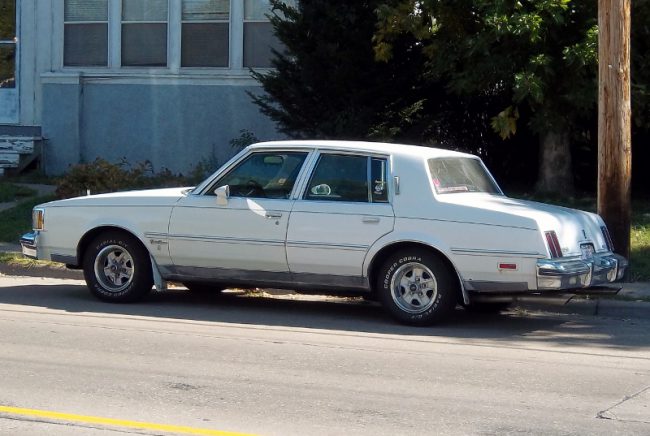
The final changes to the Cutlass Supreme sedan came in 1986. The new federally-mandated CHMSL identified ’86s from the back, while a smoothed-out eggcrate grille was prominent up front. As had been the case since 1980, the 3,320-lb. (3,341 pounds in Brougham trim) sedan’s dimensions were quite tidy compared with those of the current Delta 88, not to mention the previous decade’s Colonnade Cutlasses.
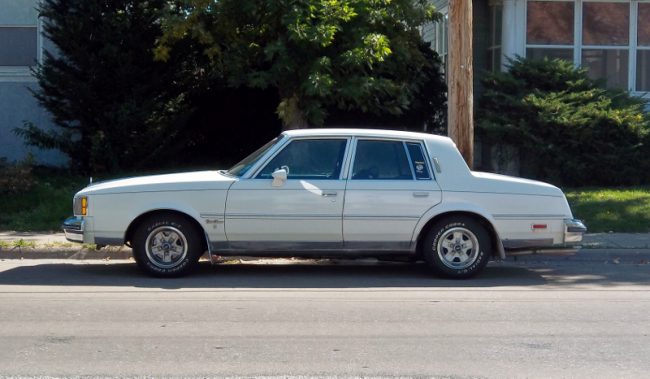
Like the coupes, the sedan measured 200.4″ in length and had a 108.1″ wheelbase. Interestingly, the coupes had one more cubic foot of trunk space than the 15.2 cu. ft. capacity of the sedans. By the 1986-87 period, Cutlass Supremes came standard with a 231 cu in, 110 hp V6; the optional four-barrel 307 V8 added 30 horses to the tally. Also standard was a three-speed automatic. A four-speed automatic with overdrive was optional.
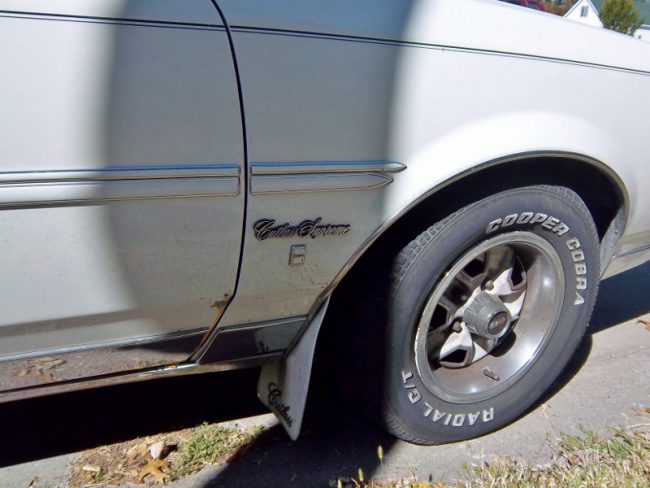
The 1986 CS sedan, which started at $10,872, was the most popular version with 41,973 copies sold. Less popular, but more plush, was the $11,551 Brougham sedan, of which 24,646 were sold. While I have identified our featured car as a 1986, the ’87s were essentially identical, so this could just as well be a final-year version.

Befitting their position in the GM hierarchy, these cars were pretty well-equipped even in standard, non-Brougham trim. Standard features included automatic transmission, deluxe wheel discs, power front disc/rear drum brakes, power steering, deluxe bumper guards and rub strips, dual outside mirrors, and bright roof drip, rocker panel and wheel opening moldings. All in all, a rather solid choice for young families in Minneapolis, Kansas City or Cedar Rapids.

The flossier Brougham, on the other hand, got lots of extras. Its niceties included chrome belt-reveal moldings, wide rocker moldings (with front and rear fender extensions), the aforementioned plush seating with a 55/45 split front bench in Summit knit velour (in place of the Bronte velour in the basic CS), and the Convenience Group, which added an under-hood light, a trunk light and all-important visor vanity mirror.
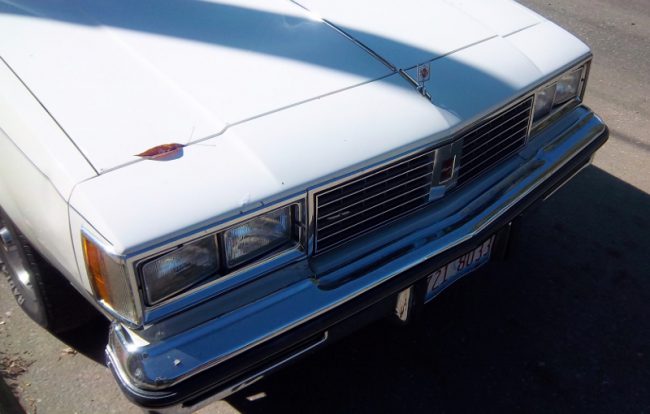
If all that additional equipment wasn’t enough, you could load your Brougham up even further with A/C, cruise control, power door locks, power front windows/rear window vents, opera lamps, vinyl roof, front and rear lamp monitors, Soft-Ray tinted glass and intermittent-pulse wipers. You could even get Sierra grain leather inside.

If you didn’t care for the deluxe wheel covers or virtually ubiquitous wire wheel covers (I estimate 95% of Cutlass Supremes had the wires), attractive chrome Super Stock wheels (digitally modeled above) were available, as were lacy-spoke alloy wheels and our featured Brougham’s color-keyed wheels with chrome trim rings.

The alloys were particularly good-looking, and I was surprised to find them in the brochure. I don’t think I ever saw these wheels on the street. They look nice, but all those little die-cut slots must have been a major pain to keep clean.
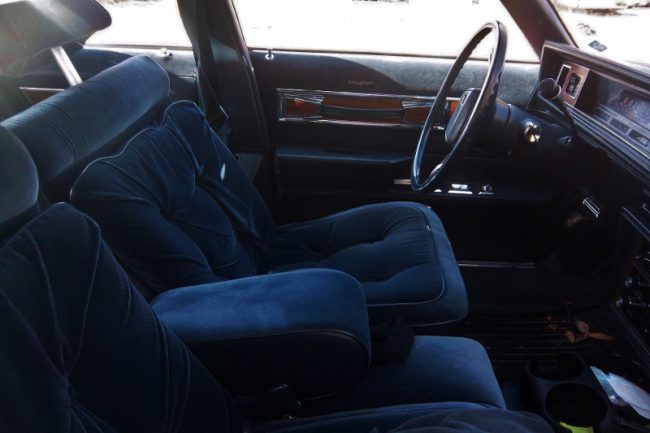
Like so many ’80s domestic cars, you really had choices when it came to interior trim. Among the five Cutlass Supreme interior colors were dark red, saddle tan and the dark blue seen here. Also offered were a wide variety of exterior colors, including Light Teal Blue, Light Sage Green, Medium Red Metallic, Yellow Beige, and classic white, as our featured car sports.
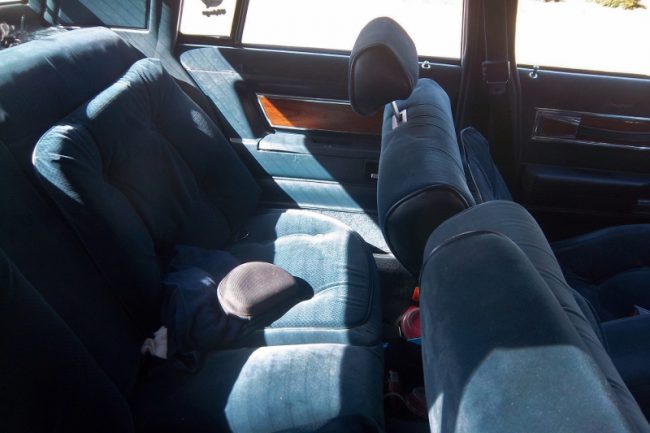
The Brougham’s back seat was just as cushy, although perhaps a bit claustrophobic with that fixed window. Yes, these sedans did not have an opening rear window, though they did have an opening vent window. On higher trimmed models, it was power-operated. But as with then-current minivans, it wasn’t as big an issue as it seemed (or as is oft-discussed online in certain quarters), unless the air conditioning konked out.
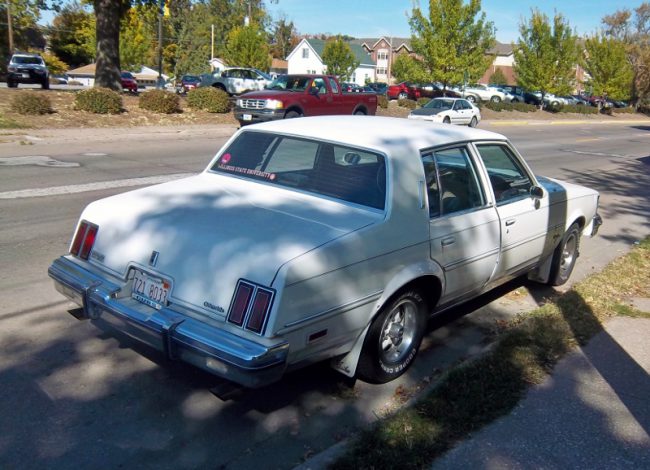
I first spotted this Brougham on the road near the Deere Works, in East Moline. All I could tell was that it was in really nice condition. Fortunately, I saw it again back on September 30, 2012. It was parked just a stone’s throw away from my old alma mater, Augustana College. While I still see the occasional 81-87 Cutlass Supreme coupe on the road, and am also spotting them more and more at car shows, this was a much more uncommon find. I don’t see many A/G-body sedans in this day and age. Seems most of these G-body four-doors all collectively disappeared around 1999-2001 or so.
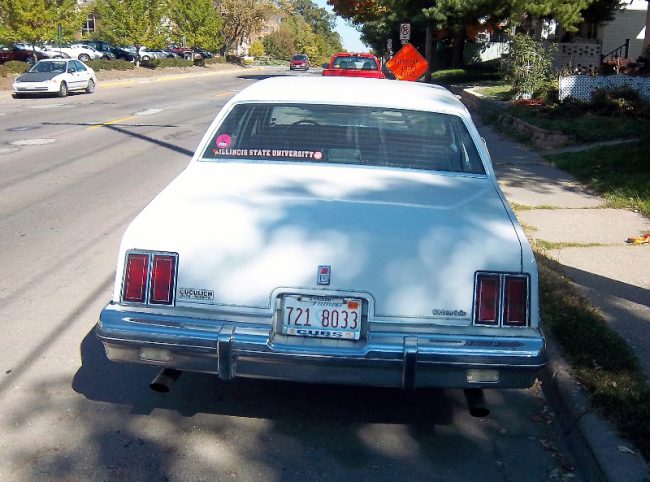
It looks like the owner is a Cubs fan, which makes sense–lots of Cubs and Cards fans in these parts. From the original dealer tag, Cuculich Olds, in Berwyn, IL, it appears to have come from the Chicagoland originally. When I attended Augie, lots and lots of students (probably three-quarters) were from Chicago and the surrounding ‘burbs. As a local, I was the odd man out. Every Friday, you could see a stream of older vehicles full of students and full of laundry, all heading east for “Scenic 88” and the Windy City.
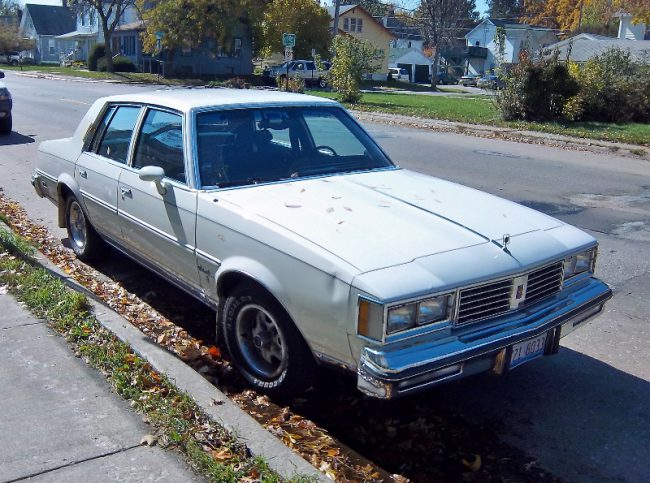
After the last G-body Cutlass Supreme Classic came off the line in 1988, Olds seemingly sabotaged itself. The swoopy new Cutlass Supreme was nice, but their questionable “not your father’s Oldsmobile” ad campaign did more harm than good: It not only alienated Oldsmobile’s traditional customers, but didn’t fool the younger buyers they were trying to attract, many of whom probably wound up buying Acura Integras. And that once ubiquitous ‘Oldsmobile feel’ was diluted out, as they started chasing the imports instead of just playing their strengths. After trying repeatedly to recapture that old Olds magic during the ’90s and early ’00s, Olds finally entered the history books after a brief 2004 model year. I still miss them today. Out of all of the makes of automobiles that have disappeared in my lifetime, I miss Oldsmobile the most.
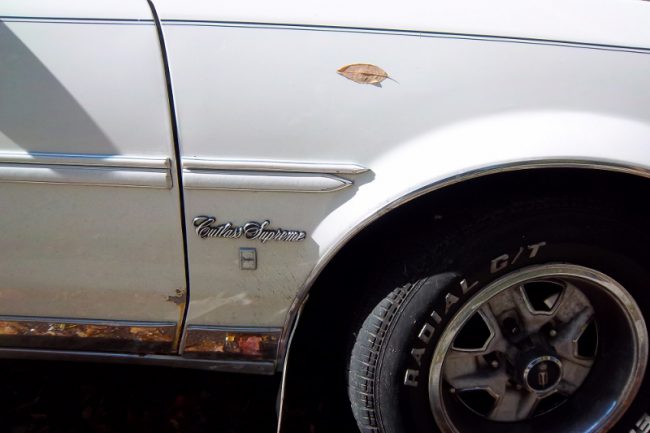
So let’s look back fondly on the Cutlass Supreme Brougham. It was a real Olds–with all the traditional Oldsmobile comfort, reliability and style–for its time.

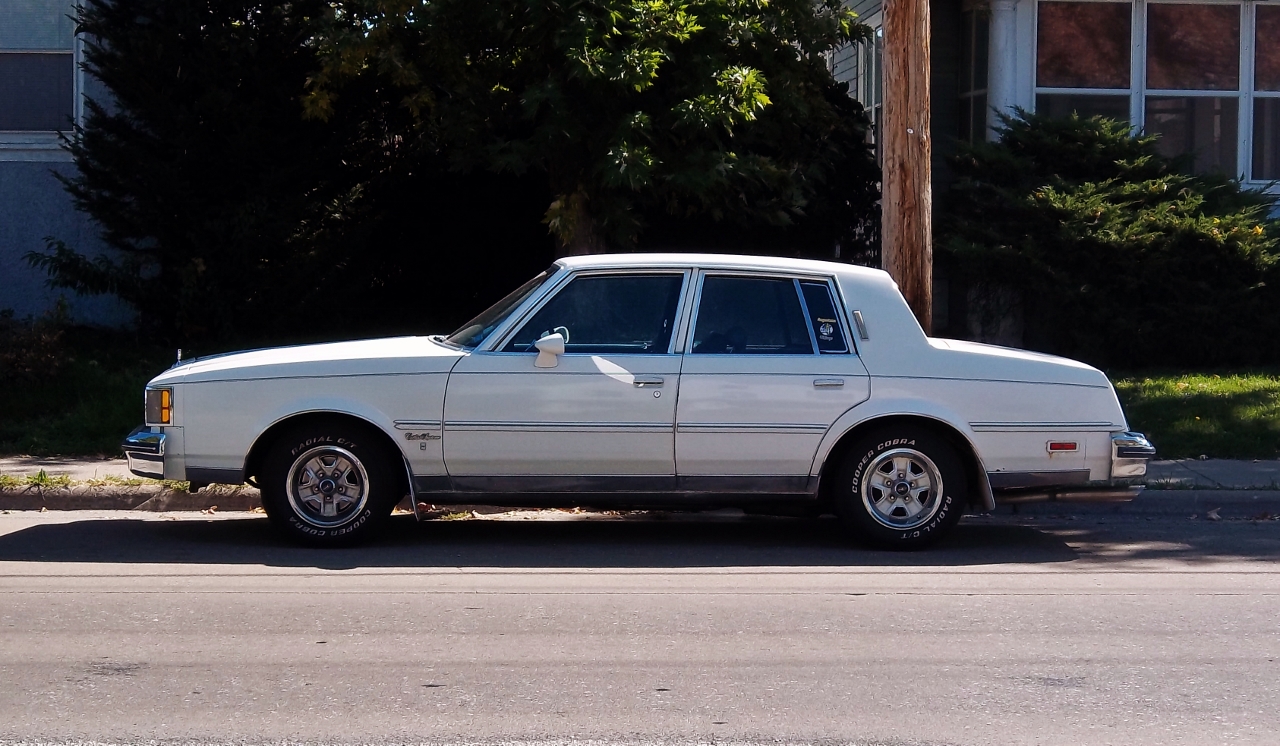
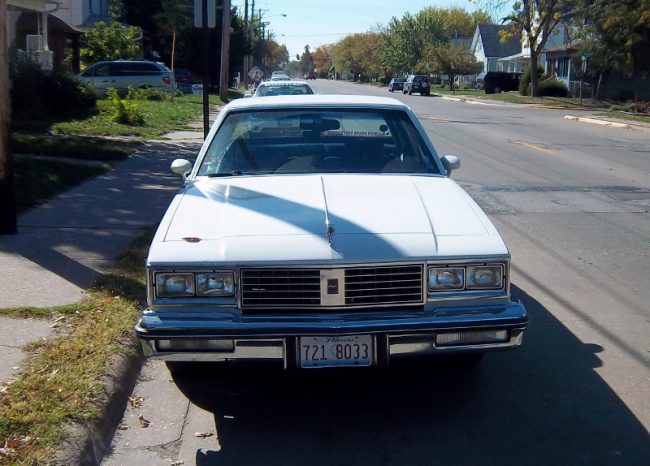






17 Comments
My Drivers Ed car was a 1981 Cutlass Supreme Brougham with the 4.4 litre small block. What a way to learn to drive!
The slim sales of the aerobacks probably cost the Cutlass the car sales title in 79, despite the sedans never being a huge part of the Cutlass story. The sales title stayed within GM but moved over to the Chevette, which had the new 5 door that year making it more for small families and less for singles. How terrifying that must have been from a profit stand point. Customers obviously wanted something smaller but how are you supposed to give them what they want when you have to actually pay your workers a living wage?
On this car, it would have been interesting if all the improvements that were happening with the 3.8 V6 made it to this model. It risked over shadowing the 307 that they were getting extra for, but the efficiency with the four speed auto might have been pretty close to the W body replacements with the 60 degree V6, with much more power and similar weight.
I’ve seen a few coupes knocking about, but the four door models have pretty much all vanished, and no aerobacks for quite a while. Up here, it was the rear frame rot and 200 series trannies that did them in. I’ve always liked the Olds version, and they seemed far more plentiful than the equivalent GM siblings. I drove a fairly original coupe a couple of years back with the 3.8Litre V-6, and it wasn’t that much slower than the 5 Litre option.
This piece makes the second time this week I have been reminded of my first car: a 1978 Olds Cutlass Salon 2-door. It was a hand-me-down, having been purchased new for my mom from Columbia Oldsmobile in downtown Cincinnati. The Gutless was light camel tan with a camel tan vinyl interior. Options included the anemic 260 V8, the fragile THM200 automatic trans, A/C, a two speaker AM radio and the color-matched rally wheels (or whatever they called them.) What a dreadful car!
I cut my teeth on the A/G-Bodies (and the FWD As to a lesser extent). My Dad had a 1980 Cutlass Sedan (basically a four-door Salon, the first year of the body style—the LS was the equivalent of the Supreme, and the Sedan Brougham was the Supreme Brougham’s four-door sister), as a company car, followed a few years later by a 1983 Regal Custom Sedan; both cars were purchased for my Mom for a song when my Dad switched to the Regal, and when he was no longer eligible for a company car, and purchased his 1986 Century Limited with the 2.8 2-bbl V6, the car which would turn my Oldsmobuick Dad into a Honda man!
Like you, my first car was a 1978 Cutlass Salon equipped like yours, in ever-so-manly Pastel Blue! The car came from my great-aunt who, like her husband, was Oldsmobile to the core, and after she was put into a nursing home after my uncle died, she insisted that I get the car. That poor Olds was neglected and used up by the time I got it, with an inch of cigarette ash on the floor and yellow-tinted windows!
It would be neat if I could find a 1987 Supreme Brougham Sedan with every box checked, including the 307 with overdrive transmission, in survivor condition, to use as a summer toy. But as I’ve lamented in several versions of this story on TTAC and perhaps on here, as Tom related, most of these are gone, and any remaining ones are probably being used to cushion the fall of a monster truck after a jump, or have all been acquired by demographic segments favoring wheels off of 747s, sound systems that could bring down skyscrapers from five blocks away, and who have the tilt steering wheels fully up, and the seat recliners permanently set at 60-degrees, at all times!
These things were ubiquitous in my childhood, and I don’t understand the nostalgia. At the time, the conventional wisdom — even among their owners — was that they were “fake broughams,” a pale shadow osf the larger land yachts of the ’60s and early 1970s.
They were slow, even in V-8 form, and the back seats were cramped. Many started rusting in their first year of contact with Midwestern road salt.
The Cutlass was a best-seller in this generation, but that just exposed more people to Detroit’s Malaise Era mediocrity. It was definitely one fo the cars that handed huge market share to the Japanese just a few years later.
Yes because Japanese malaise era cars were faster than Olds V8s (er no they weren’t), were roomier(er no they weren’t) and rusted less(no they didn’t), but hey don’t let the facts get in the way of your ideology. All Hail Hirohito
The market share curves are facts, not ideology. Would I have personally chosen an ’84 Accord over an ’84 Cutlass? Never had the desire to own either. But it’s clear that the G-Bodies did not inspire a lot of brand loyalty. By ’91 the Japanese brands had gotten a lot better very quickly, while GM was making cars that were even less inspiring than the models they had replaced. The writing was on the wall.
FWIW, two of my uncles had a Cutlasses in this era. Both blew up prematurely. One replaced his with a Nissan Stanza, the other with a Mercury Sable.
You win, who could ever compete with a Stanza? What a world beater that was.
“The market share curves are facts, not ideology”
Collectable value in 2019 are also facts. I don’t know how much “brand loyalty” the G-bodies inspired when they were new, but 30 years later I know which car people are passionate about. Folks will remember what a G-body looks like long after those J-cars are all dust.
It isn’t just Boomer nostalgia either. I was born in ’86 and something like a Monte Carlo has a lot more pull within my peer group than a Nissan Stanza, which would be a joke to all but the most afflicted Jalopnik reader.
GM’s slow adoption of overdrive transmissions in the 80’s was very frustrating. I was buying my first car and was looking at a Z24 Cavalier, Ford 5.0 Mustang, Thunderbird, and the Dodge Daytona turbo. Only the Cavalier had a 4 speed manual, all of the others had a 5 speed overdrive.
The Malibu sedan was the first to go, but I thought the Regal sedan had held on through at least 1984 or so?
The A/G sedans had wild swings, originally they were the less interesting bread and butter alternative to the hotter personal luxury coupe A/G bodies, then later they were pitched as junior Brougham sedans to die hards that were still looking for a RWD car but perhaps couldn’t or didn’t want swing that payment stretch to an 88 or a LeSabre.
I never really cared for the sedan version of these, always liked the coupes, to me the sedan was sort of an also-ran, outdated by the early 80s, especially after the FWD A-cars, in reality even the smaller FWD X-car offered better interior room and packaging 2 years before and not as impressive as a big B/C body car. There also weren’t really any interesting sedan versions, its interesting to wonder what the reaction would have been to an all blacked out Regal Grand National sedan, or even a Bonneville sedan with Rally 2’s, buckets and console and the 180hp 305 from a Monte Carlo SS.
The sedans probably should have all been dropped around 1982-1983 after the full line of FWD A-cars came out. All the RWD mid size cars were originally scheduled to die out around 1984, the N-cars(Somerset,Grand Am, Calais) were originally pitched replacements for those cars and the first run of FWD C/H cars were supposed to be out for 1983-1984, but delays with the new 4 speed auto pushed them back to 1985-1986.
A friend of mine had an 86 Cutlass Brougham sedan that he got nearly 200,000 miles out of as a daily beater, the pilowy interior still looked like new, which was one of the improvements these and the other late 70’s GM “new product” got over their lifetime, the plastics seemed to hold up much better and fade less on the later 80’s A/G/B cars compared to the first run of late 70’s A/B cars which had crumbly “multi-fade” plastics that “tan-to applesauce-raspberry” color change magic.
The Regal Sedan had one year of the revised IP with the rectangular speedo, in 1994, its last. (The Regal (and Century, before its switch to the FWD A-platform) from 1978-1983 had a three-pod IP setup, with fuel gauge, speedo and clock, and a strip of idiot lights on the right. There was a separate bank of three warning lights for cruise “set,” security system, and one other that I don’t recall—tail/liftgate ajar on the wagon, maybe—under the fuel gauge, if the particular vehicle was so-equipped.)
That was ** 1984, ** like the book and the Van Halen album! (Damn iPhone keyboard!!)
Thats what I thought, I was pretty sure I had seen one with the longer strip speedo. The original 78’s had the silver faced gauges that were all squares, with the option of having a temp/volt gauge or a temp/turbo gauge on the 2 lower blank squares. The strip on the right continued on the 84 and up cars but it was now hidden under a tinted panel
Yes, I’d forgotten about the gauges on the bottom..and I was looking at BAT or BarnFinds over the weekend, and had seen that!
Did the Malibu Sedan go to ‘83 or ‘82? (The ‘81 (“Sport Sedan”) had a billet-type grille with combination low/high-beam single headlights), but the last year(s) had the eggcrate grille with four headlights.)
I want to say the Malibu made it until at least 1982. The Regal was also the only A that never had a tachometer option, except for the LED one on the 84 and turbo cars.